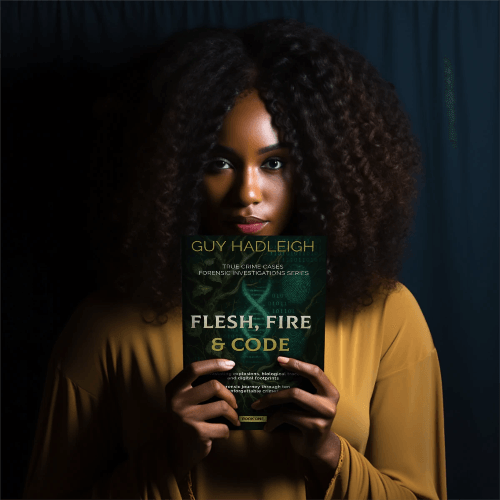A Book Born from Crime Scenes and Cryptograms
Every fingerprint. Every drop of blood. Every misplaced word.
They all tell a story.
In Flesh, Fire & Code, the first in the True Crime Cases – Forensic Investigations series, readers are taken deep inside ten real-life cases where science, psychology, and justice collide. From scorched remains to biological traces and encrypted threats, the creator of this series delivers a vivid, investigative journey that blends storytelling with meticulous research.
Among the book’s most gripping chapters is the account of the Zodiac Killer and the rise of forensic linguistics—a field that forever changed how investigators hunt criminals.
The Zodiac Letters: When Words Become Weapons
In August 1969, three identical letters containing cryptograms and sinister boasts landed on the desks of San Francisco newspapers. Signed “This is the Zodiac speaking,” they weren’t just confessions—they were tools of terror.
In Flesh, Fire & Code, the writer details how these letters became a turning point for law enforcement, pushing investigators to consider language as forensic evidence. Every misspelling, every unusual phrase was scrutinized like a fingerprint in ink.
The Birth of Forensic Linguistics
Before DNA and mass data analysis, detectives faced a new kind of suspect: the written word. The Zodiac’s deliberate misspellings (“Christmass”), old-fashioned terms (“to wit”), and cryptic phrasing revealed far more than idle threats.
The book captures the tension and innovation of this period, showing how early forensic linguists used syntax, vocabulary, and spelling patterns to create psychological profiles long before it became standard practice.
Ciphers and Cryptography: A Killer’s Playground
From the now-famous 408-character cipher to the 13-symbol mystery supposedly concealing his name, the Zodiac treated codes as both a taunt and a challenge.
The author brings these puzzles to life, following everyday citizens like Donald and Bettye Harden, who cracked the first cipher from their kitchen table. In the telling, this moment feels as thrilling as any high-speed chase—proof that intellect can sometimes be the sharpest weapon.
Psychological Profiling in Print
Forensic experts quickly realised that the killer’s language wasn’t random. His letters betrayed narcissism, a hunger for control, and a flair for performance.
Through gripping analysis, Flesh, Fire & Code connects these linguistic fingerprints to the earliest stages of criminal profiling—laying the groundwork for techniques now famous through FBI Behavioral Analysis units.
When Language Becomes Evidence
One of the most compelling ideas in the book is that punctuation, grammar, and even the way someone folds a letter can become legal evidence.
The writer examines similar cases where linguistic quirks were used in court to identify and convict criminals—from ransom notes to terror threats—demonstrating how the Zodiac case helped shape this now-global investigative practice.
Media, Manipulation, and the Court of Public Fear
The Zodiac wasn’t content to kill—he wanted control. By demanding front-page placement and setting public ultimatums, he manipulated headlines as easily as he crafted ciphers.
The creator of Flesh, Fire & Code dissects this media strategy, showing how the killer understood fear’s ability to spread faster than any police bulletin.
The Halloween Card: Poetry of a Predator
Perhaps the most infamous communication was the 1970 Halloween card sent to journalist Paul Avery. Featuring a skeleton and the line:
“I feel it in my bones, you ache to know my name…”
The chapter on this moment examines both the chilling wordplay and the psychological motives behind it—proof that the killer’s pen was as dangerous as his gun.
The Unsung Heroes: Linguists, Codebreakers, and Curious Civilians
The book doesn’t just spotlight killers—it celebrates those who fought them. Forensic linguists, codebreakers, and determined amateurs take centre stage, their quiet diligence countering the chaos of crime.
Figures like Sherwood Morrill and modern code solver David Oranchak are portrayed as intellectual detectives, piecing together clues not from blood, but from sentences.
The Lingering Legacy of the Zodiac Case
Though officially unsolved, the Zodiac investigation shaped decades of linguistic analysis. Techniques developed then now appear in cases worldwide—from identifying anonymous emails to unmasking terrorist propaganda.
One striking line from the book sums it up:
“We learned that language is evidence. And like blood, it leaves a trail.”
Why “Flesh, Fire & Code” is a Must-Read for True Crime Fans
If you’re drawn to the psychological depth of Mindhunter, fascinated by unsolved cases, or intrigued by the science behind solving crimes, this book is essential reading.
Each chapter unfolds like a case file, blending true crime drama with meticulous forensic detail. It’s both a gripping narrative and a fascinating study of the evolving science of investigation.
Frequently Asked Questions
Q1: Is “Flesh, Fire & Code” based on real cases?
Yes. Each chapter draws on verified forensic investigations, historical records, and expert testimony.
Q2: Who wrote it?
The series was created by true crime author Guy Hadleigh, a writer known for blending true crime storytelling with historical and forensic insight.
Q3: Does the book cover the Zodiac Killer?
Yes—an entire chapter is devoted to his crimes and the emergence of forensic linguistics.
Q4: Will this appeal to fans of “Mindhunter” or “Criminal Minds”?
Definitely. It’s rich in psychological profiling, behavioral analysis, and forensic storytelling.
Q5: Is it beginner-friendly for those new to true crime?
Absolutely. The writing is engaging and accessible while still delivering depth for seasoned readers.
Q6: Where can I buy it?
Available in digital and audiobook versions from Amazon
Read the Words. Follow the Clues.
Flesh, Fire & Code isn’t just a collection of cases—it’s a guided tour through the mind of both criminals and those who hunt them. From cryptic ciphers to courtroom revelations, it invites you to look closer, think sharper, and see that in crime, the smallest details often carry the loudest truths.
If you’re ready to step into the investigative world where language, science, and psychology converge, this is your next read.
📚 Get Your Copy Today


